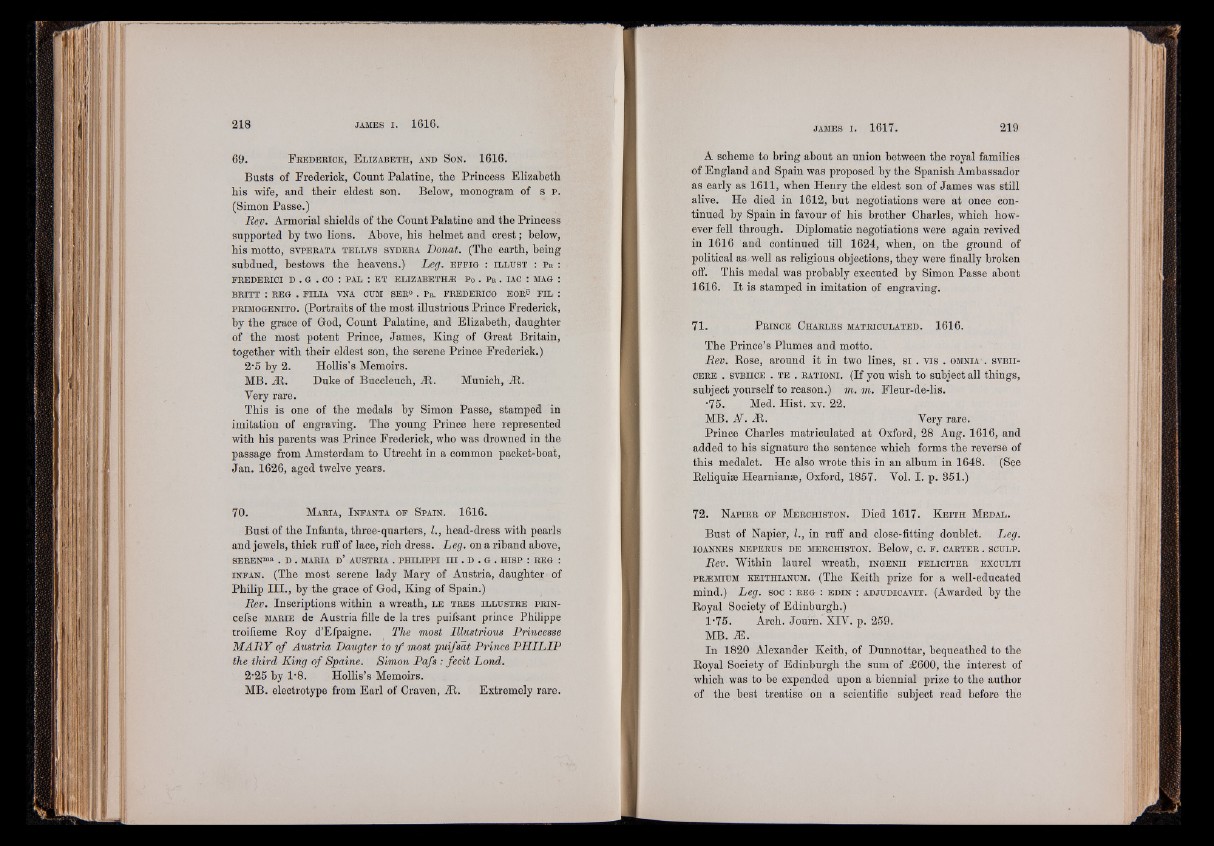
69. F e e d e b i c k , E l i z a b e t h , a n d S o n . 1616.
Busts of Frederick, Count Palatine, the Princess Elizabeth
his wife, and their eldest son. Below, monogram of s p .
(Simon Passe.)
Rev. Armorial shields of the Count Palatine and the Princess
supported by two lions. Above, his helmet and crest; below,
his motto, s v p e e a t a t e l l v s s y d e e a Donat. (The earth, being
subdued, bestows the heavens.) Leg. e f f i g : i l l u s t : pE :
FE EDEEICI D . G . CO : PAL : ET EL IZABE THS Po . P r . LAG : MAG :
BEITT : EEG . FILIA VNA CUM SEE0 . P r . FEEDEBICO EOE° F IL :
p b im o g e n i to . (Portraits of the most illustrious Prince Frederick,
by the grace of God, Count Palatine, and Elizabeth, daughter
of the most potent Prince, James, King of Great Britain,
together with their eldest son, the serene Prince Frederick.)
2'5 by 2. Hollis’s Memoirs.
MB. JR. Duke of Buccleuch, JR. Munich, Jit.
Very rare.
This is one of the medals by Simon Passe, stamped in
imitation of engraving. The young Prince here represented
with his parents was Prince Frederick, who was drowned in the
passage from Amsterdam to Utrecht in a common packet-boat,
Jan. 1626, aged twelve years.
70. M a b i a , I n f a n t a o f S p a in . 1616.
Bust of the Infanta, three-quarters, L, head-dress with pearls
and jewels, thick ruff of lace, rich dress. Leg. on a riband above,
SEBEN™1 . D . MAEIA D’ AUSTEIA . PH IL IP P I I I I . D . G . HISP : BEG :
i n f a n . (The most serene lady Mary of Austria, daughter of
Philip III., by the grace of God, King of Spain.)
Rev. Inscriptions within a wreath, l e t e e s i l l u s t e e p e in -
cefse m a e i e de Austria fille de la tres puifsant prince Philippe
troifieme Roy d’Efpaigne. The most Rlustrious Princesse
M A R Y of Austria Daugter to ye most puifsat Prince PH IL IP
the third King of Spaine. Simon Pafs : fecit Lond.
2-25 by l -8. Hollis’s Memoirs.
MB. electrotype from Earl of Craven, Jit. Extremely rare.
A scheme to bring about an union between the royal families
of England and Spain was proposed by the Spanish Ambassador
as early as 1611, when Henry the eldest son of James was still
alive. He died in 1612, but negotiations were at once continued
by Spain in favour of his brother Charles, which however
fell through. Diplomatic negotiations were again revived
in 1616 and continued till 1624, when, on the ground of
political as. well as religious objections, they were finally broken
off. This medal was probably executed by Simon Passe about
1616. It is stamped in imitation of engraving.
71. P e i n c e C h a e l e s m a t e i c u l a t e d . 1616.
The Prince’s Plumes and motto.
Rev. Rose, around it in two lines, si . vis . om n ia . s v b ii-
c e k e . s v b i i c e . t e . b a t i o n i . (If you wish to subject all things,
subject yourself to reason.) m. m. Fleur-de-lis.
•75. Med. Hist. xv. 22.
MB. N . JR. Very rare.
Prince Charles matriculated at Oxford, 28 Aug. 1616, and
added to his signature the sentence which forms the reverse of
this medalet. He also wrote this in an album in 1648. (See
Reliquiae Hearnianae, Oxford, 1857. Vol. I. p. 351.)
72. N a p i e b o f M e e c h i s t o n . Died 1617. K e i t h M e d a l .
Bust of Napier, I., in ruff and close-fitting doublet. Leg.
10ANNES NEPEEUS DE MEECHISTON. Below, C. F . CAETEE . SCULP.
Rev. Within laurel wreath, i n g e n i i f e l i c i t e e e x c u l t i
p e iem ium k e i t h i a n u m . (The Keith prize for a well-educated
mind.) Leg. soc : b e g : e d i n : a d j u d i c a v i t . (Awarded by the
Royal Society of Edinburgh.)
l -75. Arch. Journ. XIV. p. 259.
MB. M.
In 1820 Alexander Keith, of Dunnottar, bequeathed to the
Royal Society of Edinburgh the sum of ¿6600, the interest of
which was to be expended upon a biennial prize to the author
of the best treatise on a scientific subject read before the